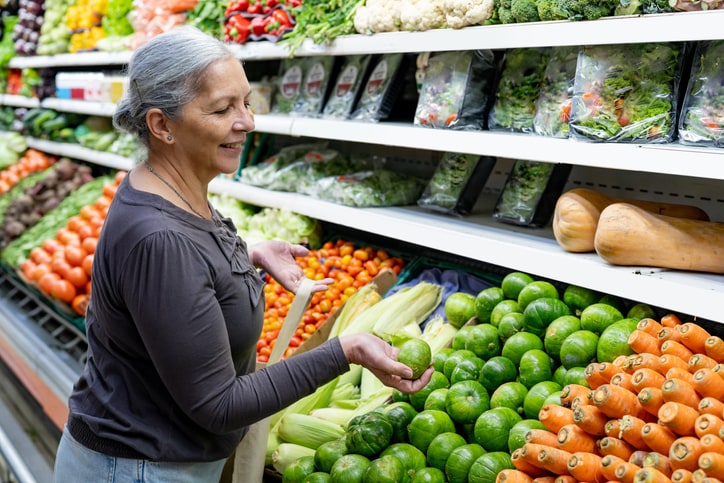In this article
- Who is eligible for Medicare grocery benefits?
- Which Medicare Advantage plans offer money for groceries?
- How does the Medicare grocery benefit work?
- Where can you use your flex card to buy groceries?
- Do plans tell you how much of your grocery benefit you have left to use?
- The takeaway on the Medicare grocery allowance
If rising prices at the grocery store are squeezing your household budget, you’re not alone. Around the country, inflation is putting an additional strain on seniors — especially those on fixed incomes. Fortunately, many Medicare Advantage plans are trying to provide some relief.
If you or a loved one qualifies, it’s worth knowing about one in four Medicare Advantage plans offer some type of financial assistance for groceries. With the Medicare grocery benefit, as it’s commonly known, you can use a prepaid flex card to purchase healthy food, produce and other products from participating retailers.
“The idea behind these [non-medical] supplemental benefits is that if people can take better proactive care of their health, they will face fewer health problems and costs in the future,” explains Robby Knight, CEO and co-founder of Soda Health, a financial services company working to change the way benefit dollars are used to improve an individual’s health and reduce health inequities. “Many Medicare Advantage plans that offer food benefits allow people to either use their benefit allowance at a traditional grocery store or they may use them for home delivered meals.”
Here, Knight and other experts offer answer to common questions about this extra benefit to help you or a loved one eat healthier and save money at the checkout.
Key takeaways
- About one in four Medicare plans offer a Medicare grocery benefit, which is a type of financial help with groceries.
- For older adults to be eligible, they must be part of a qualifying Medicare Advantage plan, which involves being enrolled in both Medicare Part A and Part B.
- Folks that are eligible for the Medicare grocery benefit will likely receive a flex card in the mail that can be used to pay for groceries
Who is eligible for Medicare grocery benefits?
To be eligible for non-medical supplemental benefits, you must first be part of a qualifying Medicare Advantage plan. And to join a Medicare Advantage plan, you must be enrolled in both Medicare Part A and Part B.
It also bears noting that many plans only give grocery and other non-medical supplemental benefits to people who meet certain requirements, such as having a chronic illness or being with the company for a set period of time.
With over 8,500 Medicare Advantage plans competing for members, many plans are using the grocery benefit as their selling point and it’s created a lot of confusion — especially on social media where many people are calling the grocery benefit a “scam.”
“The idea behind these [non-medical] supplemental benefits is that if people can take better proactive care of their health, they will face fewer health problems and costs in the future.”
— Robby Knight, CEO and co-founder of Soda Health
“We don’t know if people signing up for these plans know that only certain people are eligible for supplemental benefits like healthy groceries or if any false marketing is at play that doesn’t sufficiently explain eligibility,” says Gretchen Jacobson, vice president of Medicare at The Commonwealth Fund, a foundation that supports independent research on health care issues and makes grants to improve health care practice and policy.
The latter is likely given that a 2022 report from the U.S. Senate Committee on Finance called out the Medicare Advantage industry for misleading advertising, such as advertising benefits as extra that some patients already were entitled to, hiding the fact that only certain groups of patients are eligible for the extra benefits, like people with chronic illnesses.
You’ll want to use some caution the next time you see a plan promoting “free groceries” on your feed; there are always some eligibility restrictions involved.
Which Medicare Advantage plans offer money for groceries?
Overall, Medicare Advantage plans with a grocery allowance vary by location and plan type. Data from consulting firm ATI Advisory shows CVS Health, through Aetna and other health plans, offers grocery benefits in 234 of its 2024 Medicare Advantage plans, while Elevance Health and Humana offer grocery benefits in around 200 of their plans.
Susan Williams, a registered nurse in Orlando, Florida, first learned about Humana’s grocery benefit while reviewing her client’s Medicare Advantage plan details. “I care for an 82-year-old man with hypertension and type 2 diabetes,” she said. “This benefit has been a helpful supplement to our grocery budget and a significant help in maintaining his dietary needs.”
“Insurance companies usually go through third party companies to administer the grocery benefits; some companies do it well with easy to understand instructions, while others do not,” says Christopher Fong, CEO of Smile Insurance Group, Inc., a family run insurance agency in Arizona. If you want to see if any plans in your area offer a grocery benefit, he recommends starting with Medicare.gov. “From there, you’ll be able to go to each plan’s website and look for any information on grocery benefits within the summary of benefits and coverage,” he says.
How does the Medicare grocery benefit work?
If you’re eligible for the Medicare grocery benefit, you will likely receive a flex card in the mail that you can use like a debit card to pay for groceries. The specific amount you receive monthly depends on your plan and location. Pre-approved items also vary by plan, but they usually include:
- Fresh fruit and vegetables
- Frozen meals
- Fresh salad kits
- Dairy products
- Healthy pantry staples like beans, canned tomato products and brown rice
- Water
- Meat and seafood
If you need help or have questions, call the number on the back of the flex card, recommends Colleen Erisey, a family caregiver in Ohio. “My mom has a Medicare Advantage plan through Anthem and gets $50 per month in healthy groceries, and I’ve always found them very helpful when I’ve called on her behalf — even in the evenings after work,” she notes.
To help family caregivers and seniors navigate supplemental benefits, many companies like Soda Health offer various forms of support — from multi-lingual call centers to answer your questions to texting services that remind you to use your benefits. “While we know caregivers are heroes, we want to create a system that is easy for everyone to use successfully,” says Knight.
“My mom has a Medicare Advantage plan through Anthem and gets $50 per month in healthy groceries, and I’ve always found them very helpful when I’ve called on her behalf — even in the evenings after work.”
— Colleen Erisey, a family caregiver in Ohio
Where can you use your flex card to buy groceries?
A senior’s benefits card can only be used at participating grocery stores and retailers — and this can make it harder for people living in rural and urban food deserts to access their benefits. However, some plans have the option to buy groceries online and have them delivered to your doorstep. Instacart’s Medicare Advantage plan with Alignment Healthcare, for example, includes $50 to $100 quarterly Instacart grocery allowances and a complimentary Instacart+ membership with free delivery on qualifying orders.
Still, many who live in rural areas — far from big box stores like Walmart, Meijer and Kroger — have previously struggled to use their grocery benefit. The good news is more partnerships are expected as time goes on.
For example, in one Facebook post, Adams Food Center, a local-family owned grocery store in Preston, Georgia shared that they are now able to fill this gap in their community: “We know many of you have benefits through your Medicare Advantage plans for groceries and are having to drive out of town to use them. If you have any Humana or UnitedHealth grocery benefits that need to be used before the end of the year, come shop with us!”
Do plans tell you how much of your grocery benefit you have left to use?
When it comes to supplemental benefits, Medicare Advantage plans aren’t required to notify you about any that you’re eligible for and haven’t used nor are they required to track if you use them, where you use them, or what you purchase.
“Most benefit providers don’t keep track of this data, and this means that plans can’t learn how to be more member-centric or how supplemental benefit dollars help people take care of their health,” says Knight.
There are some developments on this issue at the federal level. CMS is now requiring Medicare Advantage plans to start reporting on the use and cost of supplemental benefits. Additionally, a proposed rule would require Medicare Advantage plans to notify you halfway through the year (likely via the mail) with information on which benefits you are eligible for and which you haven’t used yet.
“The summary of benefits documents can be really quite lengthy and complicated for people to go through, so I think this proposed rule could be very helpful,” adds Jacobson, who holds a doctorate in health economics. “A significant amount of federal dollars that go into these benefits, and we want to see more people using them.”
In the meantime, if you or someone you care for is enrolled in a Medicare Advantage plan, Knight recommends investigating the following questions:
- What supplemental benefits does your plan offer?
- How much is your benefit allowance?
- Does your benefit allowance reload monthly or quarterly, roll over month to month or is it “use it or lose it?”
- Are you eligible for any rewards and incentives (i.e., money for completing a health risk assessment, getting annual vaccines or getting regular screenings for diabetes)?
The takeaway on the Medicare grocery allowance
If you or an older loved one you care for is eligible for a grocery allowance through their Medicare Advantage plan, be sure to use it and learn about any other non-medical supplemental benefits you might be leaving on the table.
“We know many beneficiaries want more one-on-one help choosing a Medicare plan,” says Jacobson in reference to The Commonweath Fund’s recent survey findings. “The state health insurance assistance programs are really underutilized and wonderful resources for unbiased, one-on-one help.”





